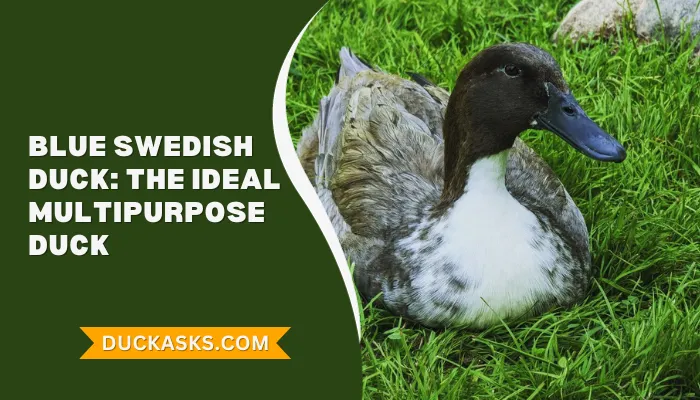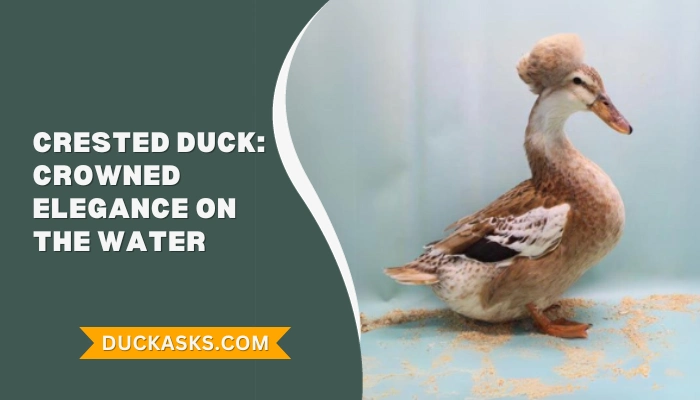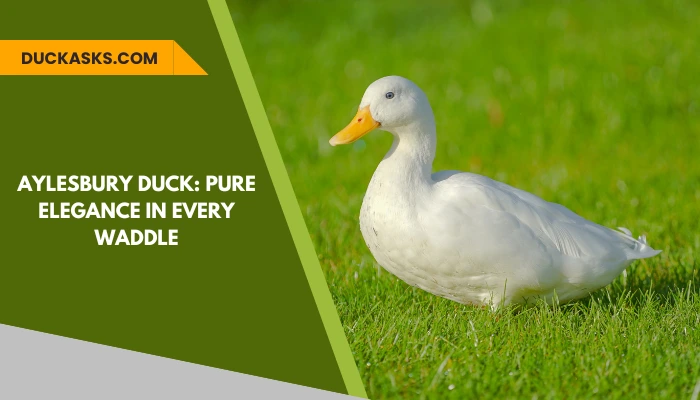Duclair Duck: History And Breed Guide
The Duclair duck is one of the most satisfying breeds to raise. Once it reaches maturity, this duck produces delicious meat and hundreds of eggs yearly.
Originally bred in Duclair, Normandy, this Rouen duck variation now has worldwide popularity.
But how exactly do you care for this duck?
To answer this question, we created an educative article discussing the most relevant information about the Duclair duck.
Find out everything you need to know about this duck, how to raise it and many other things to consider here.

Looking for more articles about duck breed:
Duclair Duck Profile
| Name | Duclair Duck |
|---|---|
| Scientific Name | Anas platyrhynchos |
| Common Names | Canard Duclair (French), Duclair Enten (German) |
| Origin | Duclair in Normandy, France |
| Size | Medium |
| Weight | 6.6 Pounds (Drakes) 5.5 Pounds (Ducks) |
| Lifespan | 12 Years |
| Feather Color | Black, Blue |
| Climate Tolerance | High |
| Behavior | Calm and Active Nature |
| Breeding and Maintenance | Easy |
| Easy to Keep? | Yes |
| Duck Purpose | Eggs and Meat Harvesting |
| Egg Productivity | Moderate |
| Rarity | Intermediate |
Overview of Duclair Ducks
The Duclair is a type of Rouen duck and it resembles the Swedish Blue. It’s considered a delicacy; the primary uses of this duck breed are producing eggs and meat.
Plus, it’s easy to tame and care for, which makes it a popular choice to the meat and eggs production farms.
History and Origins of Duclair Ducks
This duck breed developed from inbreeding domestic ducks and migratory wild ducks. The earliest record of the Duclair duck dates back to the 18th century in Duclair, Normandy.

During that time, breeders of Anneville-Ambourville raised this duck for eggs and meat. It took until 1923 for authorities to set official standards (American Standard) for this breed.
The purpose of this standard is to serve as a guide to achieving excellence in the breeding and raising of standard-bred poultry in various aspects.
Its ultimate aim is to encourage breeders to strive for perfection in accordance with the established standards. By the 20th century, the population of Duclair ducks had decreased significantly in Duclair.
This decline continued up to 2006 when the last farm that still raised them finally stopped. Then, the final commercial producer announced its closure in 2014.
Physical Characteristics and Features
The Duclair is a medium-sized duck, weighing between 5 and 7 pounds when they grow mature.

Two color varieties exist, which are black and blue. Black Duclair ducks are more common than the blue variations. In any case, both have one white feather on their wings and their bib is also white.
Here are some more details for you –
| Characteristic | Description |
|---|---|
| Size | Medium-sized and stocky |
| Height (size) | Average |
| Weight | Drake: 3 kg, Duck: 2.5 kg |
| Legs | Hardy and strong |
| Heads | Drakes: Large, round heads, Ducks: Slightly smaller heads |
| Bills | Orange in color |
| Eyes | Dark in color |
| Colors | Black, blue, white |
| Personality Traits | Friendly, docile, peaceful |
| Purposes | Egg and meat production, exhibition |
| Incubation Period | 26-28 days |
| Lifespan | 4-8 years (can live up to 12 years depending on the breed) |
Differences Between Duclair Ducks and Duclair Drakes
Differences between the Duclair drake and duck are barely noticeable, but they exist. One of the differences is the weight.
While Duclair drakes can weigh 6.6 pounds, females can weigh 5.5 pounds. Similarly, the drakes are taller than hens. Another interesting difference between Duclair drakes and hens is the color.
Male Duclair ducks are of a brighter color, whereas females are a plain color. The reason behind this trait is that hens use it to their advantage to hide and camouflage their bodies to avoid predators while in their nest.
There’s more, have a look –
| Characteristic | Duclair Drake | Duclair Duck |
|---|---|---|
| Weight | About 3 kg (6.6 pounds) | About 2.5 kg (5.5 pounds) |
| Feather Color | Mostly black or blue with a white bib | Mostly black or blue with a white bib |
| Special Features | Good foragers and known for their rich, elegant flavor | Good foragers and known for their rich, elegant flavor |
| Bills | Orange | Orange |
| Sound | Quiet raspy sounds | Loud quacking, honking, or ‘buckbuckbuck’ noises |
| Feathers | Iridescent green head | Black head |
| Flight | Not specified | Not specified |
| Unique Features | Larger and have a more rounded head | Smaller and have duller color |
How Can You Tell If a Duclair Duck Is Male or Female?
Differentiating between male and female Duclair ducks can be done through several observable traits.
Males typically have an iridescent green head and make quiet raspy sounds, while females exhibit a black head, emit loud quacks, and are generally smaller in size.
The presence of a curly feather is a unique feature found in males. These distinctions make it possible to identify the gender of Duclair ducks.
Behavior and Traits of Duclair Ducks
The temperament of the Duclair duck is one of the reasons why you will love it as a first-time breeder.

Generally, this duck breed is calm, docile and easy to tame. It’s also a very active animal, regularly foraging to find insects. Therefore, you won’t have to worry constantly.
Diet
The varied diet of Duclair ducks will allow you to feed them different foods and help them grow healthier.
For instance, you can feed these ducks the usual commercial duck or poultry feed to ensure they get all the nutrients and vitamins.
However, allowing the duck to forage is also beneficial because they can find seeds, insects, snails, plants and much more to eat.
As a result, you must find the balance between commercial food while allowing the ducks to forage and find their food.
Breeding
Duclair ducks start their mating and laying period once they are 20 to 30 weeks old. Initially, the hen will lay between five and eight eggs before sitting on them and keeping them warm for hatching.
This process takes from 26 to 28 days. Afterward, the offspring will need five or eight weeks to start flying.
Lifespan
Duclair ducks can live up to twelve years. While captive, these ducks require a rich diet and quality living conditions to maximize their livelihood and productivity.
Furthermore, measures to keep predators away are also necessary to ensure the safety of the ducks within the perimeter.
Breeding and Raising
The Duclair duck may be a delicacy, but breeding and raising this duck breed is not challenging. For this project, you must consider three factors: feeding, the mating season and proper housing.

Here’s what you need to know about these elements.
Some Tips and Considerations for Successful Breeding
- Evaluate multiple sellers and pick the most convenient one. Make sure the ducks are healthy and don’t have physical flaws.
- Some signs could indicate that the ducks are in mating season. For instance, neck biting and pecking is usual behavior during this period. Make accommodations and don’t intervene.
- Address other unusual behavior and act accordingly. If you identify erratic actions or the ducks are behaving differently, consider it may be an illness. Take the duck to the vet as soon as possible.
- Keep the mating pair together and avoid inbreeding. Otherwise, egg production may decrease due to these biological issues.
Feeding and Housing Requirements
The quality and productivity of a good Duclair duck will heavily depend on its housing conditions.
So, prepare a duck house or coop with good ventilation and enough airflow to keep them healthy. This area must offer at least four square feet of housing space per duck, as Duclair ducks are of medium size.
Good fencing is also necessary. Enclose the perimeter with a wood or metal fence to ensure the ducks remain inside and predators won’t come close.
Feeding
Feeding a Duclair duck is similar to how you would feed other ducks. You must provide food early in the morning and a second time later in the day.
Also, you must keep track of the food amount to ensure the ducks get a proper amount. Increase the amount if they eat all of it, or reduce it if there are plenty of leftovers the following day.
The Egg Productivity of Duclair Ducks
Duclair hens produce from 80 to 100 eggs. The eggs are large, weighing 70g and are blue, green, or shades between those colors. You can use these eggs for different applications, like general cooking or baking.

They have rich yolks with a pleasant texture and good proteins.
The Duclair duck is not the most capable egg layer, but it’s still decent. Typically, farmers raise this duck breed for small-scale farming or as part of a flock.
The Meat Quality and Popularity of Duclair Ducks
Did you know that the first meat used to create the Pressed Duck dish was Duclair meat?
Furthermore, the meat of this duck is also suitable for other recipes, such as roast duck. This is because the duck is exquisite and usually considered a high-quality delicacy.
The Duclair duck meat is delicious and the duck takes between seven to twelve weeks to reach mature size.
Typically, the slaughtering technique is the reason behind the flavor of the duck. While decapitation is the usual method, a local tradition recommends suffocating instead to prevent blood drainage.
Frequently Asked Question
- Are Duclair Ducks Good for Small-Scale Farming?
Yes, the Duclair duck is a rewarding bird for small-scale farming applications. This duck lays a moderate number of eggs and the meat is in high demand in the big cities.
- How much are Duclair ducks worth?
Duclair ducks are worthy birds offered at high prices, usually between $13 (males) and $16 (females). Of course, buying in bulk can lower the price significantly.
- Can Duclair ducks fly?
Duclair ducks can fly, but their flight ability is poor. Thus, you don’t have to worry about the ducks flying away or having to clip their wings. Create a secure parameter and the Duclair will be fine.
Conclusion
The Duclair is a versatile duck you can breed and raise for multiple reasons. With elevated egg productivity and a delicious taste, this duck offers fantastic opportunities for small-scale farmers.
And if you don’t want any of that, this duck breed also makes for good pets and companions to adults and children.
What’s there not to love? Like the Duclair duck, many other breeds exist with fascinating backgrounds and purposes.
Find all about the most popular duck breeds and much more by following us on Twitter, Facebook and Pinterest. We post articles and other interesting pieces about ducks and birds regularly, so don’t miss out!
REFERENCES:
- https://www.beardsleyzoo.org/duclair-duck.html
Image Credits:
- https://www.instagram.com/jrg.photography/
- https://www.instagram.com/briarpatchfarm/
- https://www.instagram.com/ftv.photography/






